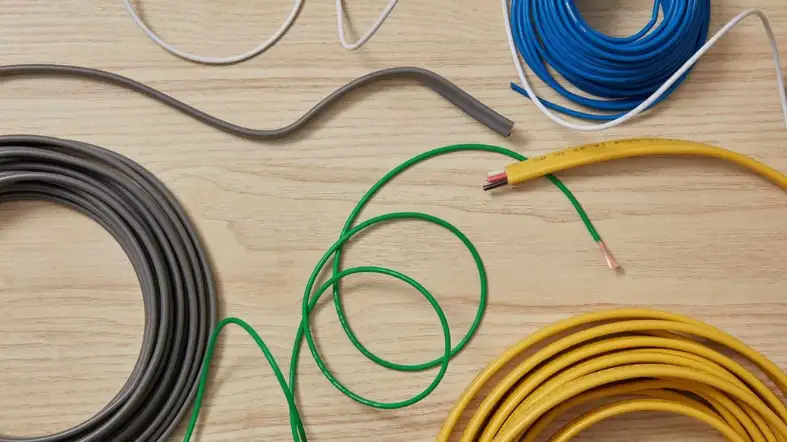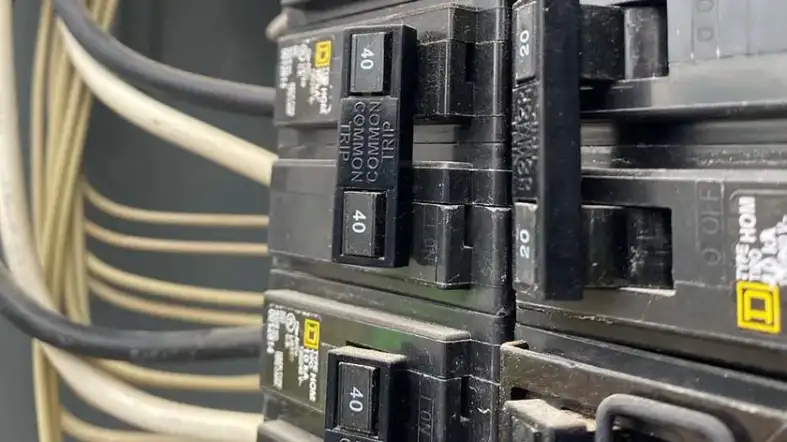Choosing the Right Wire Size isn’t just about adhering to safety standards; it’s a critical element for the performance of your electrical circuits. It needs to go through several factors such as the material of the wire, installation method, environmental conditions, budget constraints, and local building codes and regulations.
In this article, we will explore what size wire for 20 amp, the factors that influence it, and a detailed guide to determine the appropriate wire size.

What Size Wire for 20 Amp?
The correct wire size for a 20-amp circuit is 12 AWG. This wire size can safely carry 20 amps up to 100 feet. If you need to run the wire in conduit or over 100 feet, upgrade to a 10-gauge copper wire.
20-amp Circuit Wire Size Chart:
| Wire Gauge | Max Amps | Max Distance |
|---|---|---|
| 14 AWG | 15 | 50 ft |
| 12 AWG | 20 | 100 ft |
| 10 AWG | 30 | 200 ft |
Types of Wires for 20-Amp Circuits
There are several types of wires that are suitable for use in a 20-amp circuit. These include THHN/THWN wires, UF-B wires, and NM-B wires.
THHN/THWN Wires
THHN/THWN wires are commonly used in residential and commercial wiring. They are made of copper and have thermoplastic insulation.
For example, if you’re wiring a new room in your house, you might use THHN/THWN wires to connect the outlets and switches to the circuit breaker.
UF-B Wires
UF-B wires are used for underground installations. They have tough, moisture-resistant insulation and are suitable for direct burial.
For example, if you’re installing an outdoor lighting system, you might use UF-B wires to run power from your house to the lights.
NM-B Wires
NM-B wires are used in residential wiring. They have a non-metallic sheath and are suitable for use in dry locations.
For example, if you’re adding a new light fixture in your living room, you might use NM-B wires to connect the fixture to the switch.
Determining Wire Size for a 20-Amp Circuit

Determining the appropriate wire size for a 20-amp circuit is crucial to ensure safety and prevent electrical problems. Here are the steps to determine the appropriate wire size for a 20-amp circuit:
Step 1: Determine Total Wire Length
Determine the total length of the wire. Measure the distance from the circuit breaker to the farthest outlet on the circuit. This will help you determine the appropriate wire size.
Step 2: Calculate Voltage Drop
Voltage drop is the reduction in voltage that occurs as electricity flows through the wire.
To calculate voltage drop, you need to know the length of the wire, the amperage of the circuit, and the resistance of the wire. You can use an online voltage drop calculator to make this process easier.
Step 3: Choose the Appropriate Wire Size
Once you have calculated the voltage drop, you can choose the appropriate wire size. For a 20-amp circuit, the most common wire size is 12 AWG.
This wire size can safely carry 20 amps up to 100 feet. If you need to run the wire in conduit or over 100 feet, upgrade to a 10-gauge copper wire.
Step 4: Consider Wire Type
Types of Wires
There are different types of wires that are suitable for a 20-amp circuit, including copper wire, aluminum wire, and copper-clad aluminum wire.
Common Wire Gauges
Copper wire is the most common wire used for a 20-amp circuit, and the most common gauge is 12 AWG.
Aluminum wire and copper-clad aluminum wire are cheaper alternatives to copper wire, and the most common gauge for a 20-amp circuit is 10 AWG.
Factors Affecting Wire Size for 20-Amp Circuits
There are several factors that can influence the size of the wire needed for a 20-amp circuit. Let’s take a closer look at each of these factors:
Material of Wire: Copper vs. Aluminum
The material of the wire can affect its ability to carry current. Copper wires have lower resistance than aluminum wires, so they can carry more current with less voltage drop.
For example, if you’re wiring a circuit that needs to carry a lot of current, you might choose to use copper wires instead of aluminum wires.
Installation Method
The way the wire is installed can also affect its performance. Wires installed in conduit or surface-mounted may require larger sizes than those installed in open air. This is because the wire needs to be able to dissipate heat effectively.
For example, if you’re installing a wire in a conduit, you might need to use a larger wire size to ensure that it doesn’t overheat.
Electrical Codes and Standards
Local electrical codes and standards may specify minimum wire sizes for certain applications. It’s important to follow these codes and standards to ensure that your wiring is safe and up to code.
For example, if your local electrical code requires a minimum wire size for a 20-amp circuit, you’ll need to make sure that you use a wire that meets or exceeds that requirement.
Environmental Conditions
Environmental conditions such as moisture, corrosive substances, or extreme temperatures can affect the performance of electrical wiring.
For example, if you’re installing a wire in an area that’s exposed to moisture or corrosive substances, you might need to use a wire with special insulation or coating to protect it.
Budget Constraints
The cost of materials may influence the choice of wire size. If you’re working within a tight budget, you might need to choose a smaller wire size to save money.
However, it’s important to make sure that the wire size you choose is still safe and appropriate for the application.
Special Equipment or Appliances
Some equipment or appliances may require larger wire sizes to operate safely and efficiently.
For example, if you’re wiring an appliance that uses a lot of power, such as an electric range or air conditioner, you might need to use a larger wire size to ensure that it can handle the load.
Local Building Codes and Regulations
Local building codes and regulations may specify minimum requirements for electrical wiring. It’s important to follow these codes and regulations to ensure that your wiring is safe and up to code.
Common Mistakes When Selecting Wire Size for 20-Amp Circuits

There are several common mistakes people make when selecting wire size for a 20-amp circuit. Let’s examine each of these mistakes:
Using Lower Gauge Wire
One common mistake is using a lower gauge (thinner) wire than recommended. This can cause the wire to overheat and increase the risk of fire.
For example, if you’re wiring a 20-amp circuit and you use a 14-gauge wire instead of the recommended 12-gauge wire, the wire could overheat and cause a fire.
Ignoring Temperature Ratings
Another common mistake is ignoring temperature ratings. Wires have temperature ratings that indicate the maximum temperature they can safely operate at.
If you use a wire with a lower temperature rating than the ambient temperature, the insulation on the wire can degrade, reducing its current-carrying capacity.
For example, if you’re wiring an outdoor outlet in a hot climate and you use a wire with a low-temperature rating, the insulation on the wire could degrade and cause the wire to overheat.
Not Considering Load Types
It’s also important to consider whether the load on the circuit is continuous or non-continuous. A continuous load operates for three hours or more at a time, while a non-continuous load operates for less than three hours at a time.
Continuous loads require larger wire sizes than non-continuous loads. If you don’t consider the type of load when selecting a wire size, you could end up choosing an inappropriate wire size.
For example, if you’re wiring an appliance that will be used continuously, such as an air conditioner, and you don’t consider the fact that it’s a continuous load, you might choose a smaller wire size than is safe.
Safety Tips for Installing 20-Amp Wires
When installing 20-amp wires, it’s important to follow these safety tips to ensure a safe and successful installation:
Turn Off Main Power Supply
The first and most important safety tip is to always turn off the main power supply before working on electrical wiring. This will prevent accidental electrocution and reduce the risk of electrical shock.
For example, if you’re installing a new outlet, make sure to turn off the main power supply before you start working on the wiring.
Use Insulated Tools
Another important safety tip is to use insulated tools when working on electrical wiring. Insulated tools have a special coating that prevents electricity from flowing through them, reducing the risk of electrical shock.
For example, if you’re using a screwdriver to connect wires to an outlet, make sure to use an insulated screwdriver to reduce the risk of electrical shock.
Follow All Safety Protocols
It’s also important to follow all safety protocols and guidelines when installing 20-amp wires. This includes wearing protective gear such as gloves and safety glasses, and following the manufacturer’s instructions for the materials and tools you’re using.
For example, if you’re using a wire stripper to strip the insulation from a wire, make sure to follow the manufacturer’s instructions for how to use the tool safely.
FAQs
Can I use 14-gauge wire for a 20-amp circuit?
Is aluminum wire suitable for 20-amp circuits?
Are UF-B wires good for outdoor wiring in a 20-amp circuit?
Do I need to consider temperature ratings for wire selection?
Is a 10-gauge wire overkill for a 20-amp circuit within 100 feet?
Conclusion
Choosing the right size wire for a 20-amp circuit is important for safety and efficiency. A 12-gauge wire is typically used for a 20-amp circuit, but several factors can influence the appropriate wire size.
It’s important to consider all of these factors when selecting wire size for a 20-amp circuit. Remember to always follow safety protocols when installing electrical wiring. I hope this post has been helpful in providing information on what size wire to use for a 20-amp circuit!
